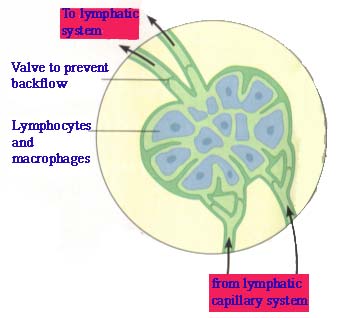第五章 心血管和淋巴系统与病毒性疾病Cardiovascular and Lymphatic Systems and Viral Diseases
第一节 淋巴系统主要结构与功能
STRUCTURE AND
FUNCTION OF THE LYMPHATIC SYSTEM
 |
 |
淋巴系统是血液循环的重要部分。当血液循环时,一些血浆渗出毛细血管进入组织和细胞间的空间,即胞间隙。这种循环中的液体称为组织液。环绕组织细胞的显微淋巴管称为淋巴毛细管;它们比毛细血管更粗和透性更大。当在组织细胞间流动时, 组织液被淋巴毛细管收集进入毛细管成为淋巴。
The lymphatic system is an essential part of the circulation of blood. As
the blood circulates, some plasma filters out of the blood capillaries
into spaces between tissue cells called interstitial spaces. The
circulating fluid is called interstitial fluid.
Microscopic lymphatic vessels that surround tissue cells are called lymph capillaries; they are larger and more permeable than blood
capillaries. As the interstitial fluid moves around the tissue cells, it
is picked up by the lymph capillaries; the fluid is then called lymph.
lymphatic [lim5fAtik]
adj.含淋巴的,
淋巴腺的
lymphatic system n. 淋巴系统
filter [5filtE]
n.滤波器,
过滤器,
滤光器,
筛选vt.过滤,
渗透,
用过滤法除去
interstitial [7intE(:)5stiFEl]
adj. 空隙的,
裂缝的,
形成空隙的
interstitial space胞间隙
filter out 渗漏
capillary [kE5pilEri]
n.毛细管
adj.毛状的,
毛细作用的
capillaries n.微血管,毛细管
vessel [5vesl]
n.船,
容器,
器皿,
脉管,
导管
permeable [5pE:miEbl]adj.有浸透性的,
能透过的
arteriole
[B:`tIErIEJI]n.细动脉
venule [5venju:l]n.[解]小静脉,
[昆]小翅脉
因为淋巴毛细管通透性大,而很容易收集微生物及其产物。淋巴从淋巴毛细管运输到更粗的淋巴管。淋巴管内具有瓣膜,可以保证淋巴向心脏。最后,淋巴汇入血液,进入右心房。循环后,一些从血浆中渗出的蛋白质和液体重新回到血液中。
Because lymph capillaries are very permeable, they readily pick up microorganisms or their products. From lymph capillaries, lymph is transported into larger lymph vessels called lymphatics, which contain valves that keep the lymph moving toward the heart. Eventually, all the lymph is returned to the blood just before the blood enters the heart's right atrium.As a result of this circulation, proteins and fluid that have filtered from the plasma are returned to the blood.
readily [5redili]adv.乐意地,
欣然,
容易地
lymphatic [lIm5fAtIk]
adj. 淋巴的,分泌淋巴的,n.淋巴管
atrium [5B:triEm]n.中庭,
心房;里腔,位于海绵体体壁内部的腔。围鳃腔
gangrene [5^AN^ri:n]n.坏疽,
腐败堕落的vi.生坏疽,
腐败 vt.使生坏疽
gas gangrene
气性坏疽
在淋巴系统的不同位置有许多椭圆形的结构称为淋巴结,淋巴流经此处。在淋巴结内有巨噬细胞可清除淋巴内的病原微生物。有时淋巴结本身本感染,形成可见而柔软的肿大。这种肿大的淋巴结称为
At various points in the lymphatic system are oval structures called lymph nodes, through which lymph flows. Within the lymph nodes are fixed macrophages that help clear the lymph of infectious microorganisms. At times the lymph nodes themselves get infected and become visibly swollen and tender; swollen lymph nodes are called buboes.
oval [5EuvEl]adj.卵形的,
椭圆的 n.卵形,
椭圆形
bubo [5bju:bEu]
n.[医]腹股沟腺炎
淋巴结也是机体免疫系统的重要组成。外来微生物进入淋巴结后会遇到2种淋巴细胞:一种是B细胞,遇到抗原刺激后会形成浆细胞产生抗体;另外一种是T细胞,是机体的细胞免疫系统的基本组成。
Lymph nodes are also an important component of the body’s immune system. Foreign microbes entering lymph nodes encounter two types of lymphocytes: B cells, which are stimulated to become plasma cells that produce humoral antibodies; and T cells that are essential to the cell-mediated immune system.